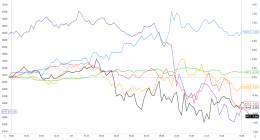
In April 2017, just a few months into the Trump administration, hundreds of thousands of people took part in a “March for Science” in Washington, DC, and in cities all around the world. Some worried at the time that the nominally nonpartisan event was too political and would damage the credibility of institutional science. Others argued that its activism should have been far more overt. Now, three and a half years later, it appears this tension has been resolved. In the past few weeks, some of the most prestigious scientific and medical journals—including Nature, Science, and The New England Journal of Medicine—have issued editorials that more or less denounce President Donald Trump and endorse Joe Biden in the upcoming election. Journalists and social media pundits have reacted to the trend with varying degrees of admiration or apprehension, but nearly always with surprise that a long-hallowed split between science and politics has finally evaporated.
The notion that this split can and must exist—and that scientific journals are important for enforcing it—is largely a fiction. It’s also one of relatively recent vintage. The conceit that the scientific literature can be a bastion of objectivity, and that it can keep scientific truth in quarantine from politics, is neither permanent nor realistic; and if it’s gone into decline, perhaps that’s for the best.
There is indeed a long-standing idea—once championed by serious historians—that the relationship between science and states is normally constrained so as to keep the two at a respectable distance. According to the terms of that arrangement, scientists produce knowledge that can be turned into practical value through technologies and rational policies, and in return they receive institutional support and funding from the state to do that work. Some might now argue that, as this arms-length but mutually beneficial pact has broken down, representatives of the American scientific community have been compelled to enter the unfamiliar arena of politics. But this isn’t quite right.
The thing is, modern nations have often used their patronage of science to shore up their own political legitimacy. The enlightened absolutism of prerevolutionary France, for example, was meant to harness the practical benefits of science—producing instruments of war, improvements in agriculture, and controlling epidemics, for example—but also its ideological potential, by recasting matters of governance as problems that could be solved by science. (The yoking of science to the monarchy was one reason that the Paris Academy of Sciences was shut down as politically suspect after the revolution.) During the 20th century this relationship was again in full view, in the public role given to science—especially the Indian nuclear program—by Jawaharlal Nehru in his efforts to forge Indian independence. Science was also central to American cultural diplomacy during the Cold War, as scientific ambassadors from the US trumpeted the benefits of “scientific freedom.” As historian Audra Wolfe has recently shown, these actors could be politically engaged—even critical of US policy—and still support American strategic objectives in the global fight against Communism.
Ironically, that very Cold War ideal of scientific freedom is in part to blame for the pesky idea that science must be insulated from politics. And the international system of scientific journals—including Science, Nature and The New England Journal of Medicine, among many others— came to play an outsize role in this Cold War vision, as the appointed guardians of independent truth.
It was not always so. In earlier times it was common for periodicals, including those that focused on science or medicine, to be identified with some political orientation. Just as many news sites today remain known for a political stance even as they endeavor to adhere to journalistic standards, it was not uncommon in the 19th century for scientific journals to cultivate partisan reputations. Extreme instances can be found in post-revolutionary France, where editors of publications such as the Journal de physique (founded 1785) and the Annales des sciences d’observation (founded 1829) made little effort to hide their activist political commitments. In England, meanwhile, The Lancet (founded 1823) was one among many publications that blended political and social advocacy with science and medicine. Even the French Academy of Sciences’ weekly journal of short research notes, the Comptes rendus hebdomadaires (founded 1835), which established the blueprint for prestigious journals from Nature to Physical Review Letters, was created by the astronomer (and sitting parliamentarian) François Arago in response to bitter partisan conflict over press freedoms and access to the academy’s meetings.








